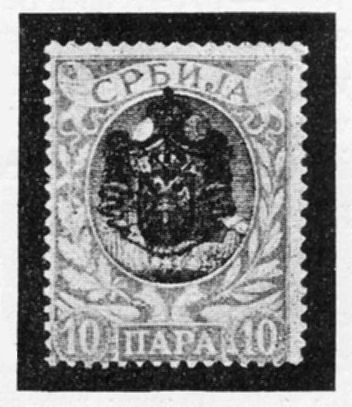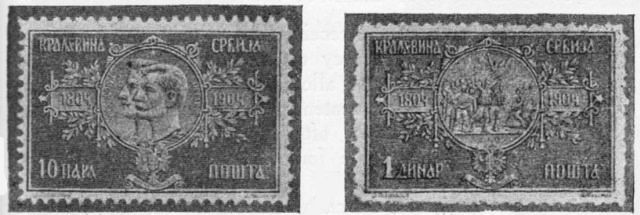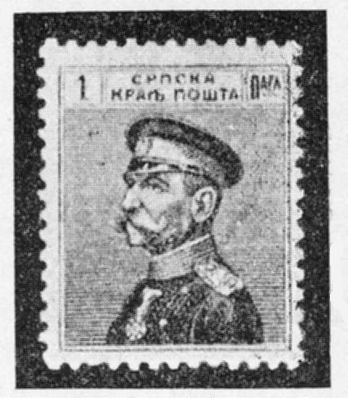 Revolutionary disturbances led to changes of the stamps of Serbia. Michael Obrenovich III., who figures on the issue of 1866, was assassinated on June 10th, 1868, by the friends of the abdicated prince, Alexander Karageorgevich.
Revolutionary disturbances led to changes of the stamps of Serbia. Michael Obrenovich III., who figures on the issue of 1866, was assassinated on June 10th, 1868, by the friends of the abdicated prince, Alexander Karageorgevich. Milan IV., his successor, had a troubled reign; during his period the country was recognised as a kingdom with Milan as king, but he abdicated in 1889 in favour of Alexander, his son. The portraits of Milan and Alexander figure on the stamps of their respective reigns, and in the case of Alexander we get one of those philatelic issues which must imprint on our minds the memory of notable or notorious events. Alexander and his consort, Queen Draga, were assassinated by a number of military officers in 1903, and the house of Karageorgevich once again ruled in Serbia in King Peter. At the time of the assassination a new series of stamps bearing the portrait of Alexander was in readiness for issue, but before they were sent out under the new regime the effigy of the murdered king was almost completely obliterated by the overprinting of a design of the Serbian Arms.
The year following the grimmest of all the royal tragedies of Serbia the surviving dynasty commemorated its centenary, and issued perhaps the most sensational stamp series known to collectors. These will go down to posterity as the "Death Mask" stamps, although the curiosity of artistry which led to this designation probably owes more to the excited imagination of the Serbian and foreign public than to any gruesome intent on the part of revolutionary artists.
 The Coronation stamps of King Peter, issued September 21, 1904, are of large size, and in two designs, by G. Janovic. M. Mouchon was the engraver, and the stamps were printed at the French Government Stamp Printing Factory in Paris. The names of the designer and engraver appear in microscopic letters below the design of each stamp. The first design shows a medal on which the profile of the new King Peter is superimposed upon the profile of the founder of the dynasty "Kara," or Black George. The names inscribed upon the medal are KARA GJORGJE at left, and PETAR I. at right. To the left and right of the medal respectively are the centennial dates 1804-1904, and below are the Serbian Arms, with the motto SPES MIHI PRIMA DEUS. Along the top of the stamp in Sclavonic characters is KRALJEVINA SRBIJA (Kingdom of Servia), the value in PARA is in the lower left corner, and the word POSHTA in the lower right corner. This design was used for all the para values.
The Coronation stamps of King Peter, issued September 21, 1904, are of large size, and in two designs, by G. Janovic. M. Mouchon was the engraver, and the stamps were printed at the French Government Stamp Printing Factory in Paris. The names of the designer and engraver appear in microscopic letters below the design of each stamp. The first design shows a medal on which the profile of the new King Peter is superimposed upon the profile of the founder of the dynasty "Kara," or Black George. The names inscribed upon the medal are KARA GJORGJE at left, and PETAR I. at right. To the left and right of the medal respectively are the centennial dates 1804-1904, and below are the Serbian Arms, with the motto SPES MIHI PRIMA DEUS. Along the top of the stamp in Sclavonic characters is KRALJEVINA SRBIJA (Kingdom of Servia), the value in PARA is in the lower left corner, and the word POSHTA in the lower right corner. This design was used for all the para values.For the higher values in dinar, the same frame design is used, but for the medallion what may have been the reverse of a Coronation medal is shown. This is reputed to be an allegory representing the successes of the guerrilla leader Kara-George, founder of the dynasty against the Turks in 1804. There is a minute inscription on the medallion below the picture signifying THE DAWN OF LIBERTY, 1804.
These stamps were at first received by collectors with disdain and some disgust; the memory of the tragedy of June 10th, 1903, was still too fresh to allow the world to join readily in any jubilation over the centenary of a dynasty which had been dragged from obscurity after many years, to occupy a throne lately emptied by the foul hands of assassins. It is even said that the early sales of the stamps were entirely disappointing. But this was all changed from the moment rumours of a cunning intrigue attached themselves to the issue.
 |
| King Peter |
Includes edited excerpts from The Project Gutenberg e-Book of The Postage Stamp in War, by Fred. J. Melville

You have shared very good information, they are really important. And people have the great curiosity to know about such information. Thank you so much for this
ReplyDeleteLabito Zipcode
This is absolutely exceptional. Even though variety of article on this topic, this article carries many treasured points which had been never be read in other articles.
ReplyDeletenagaur postal code